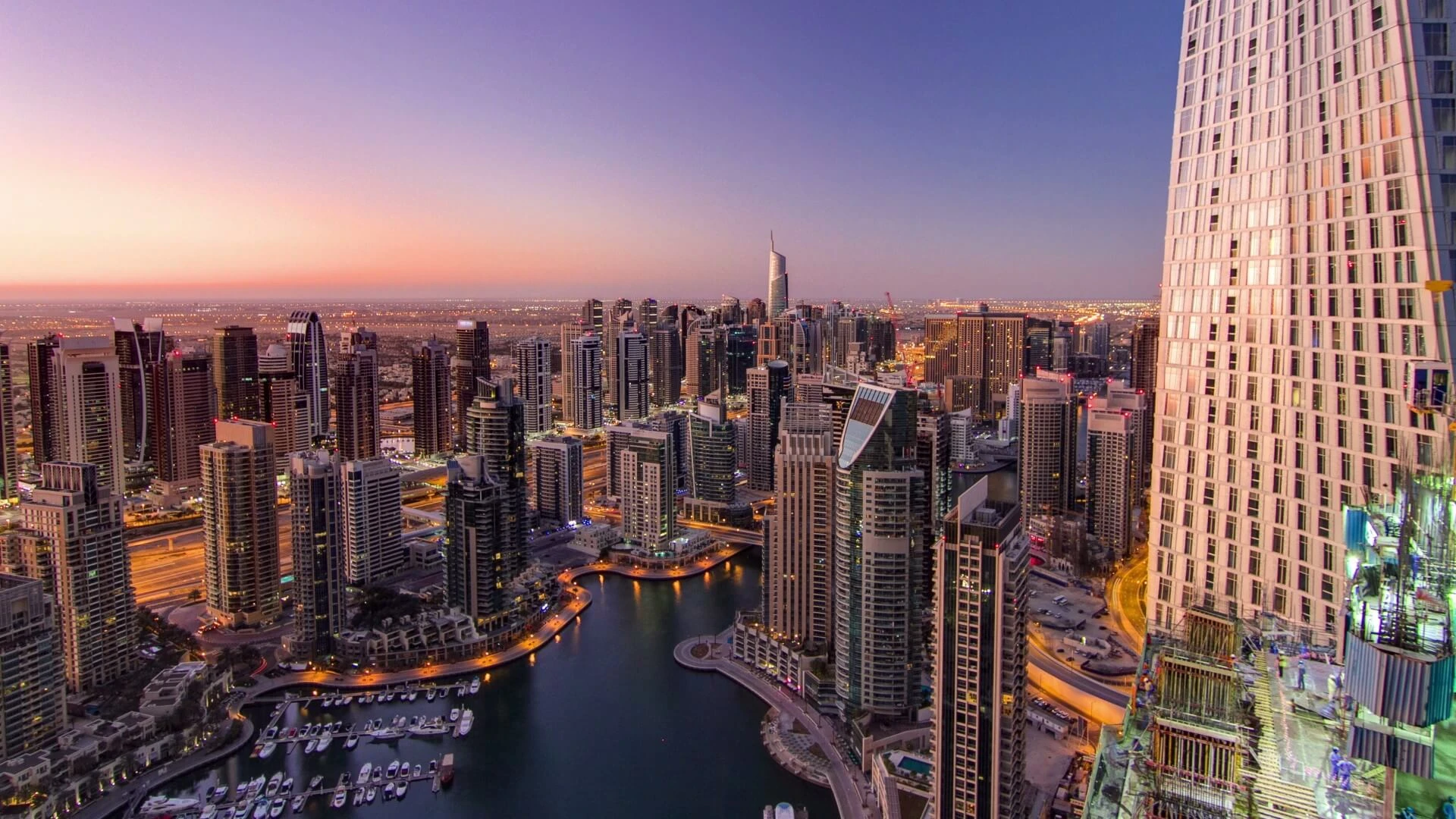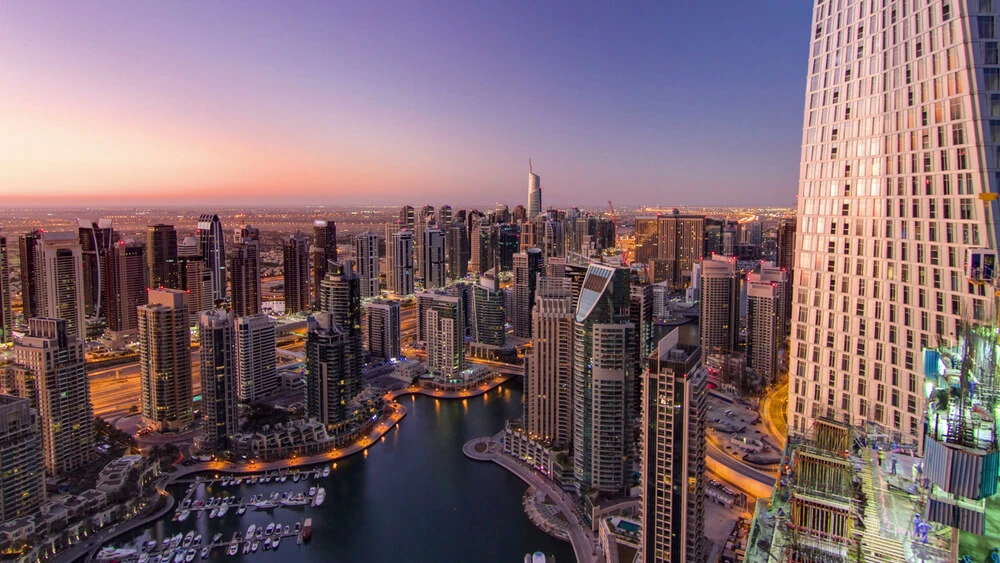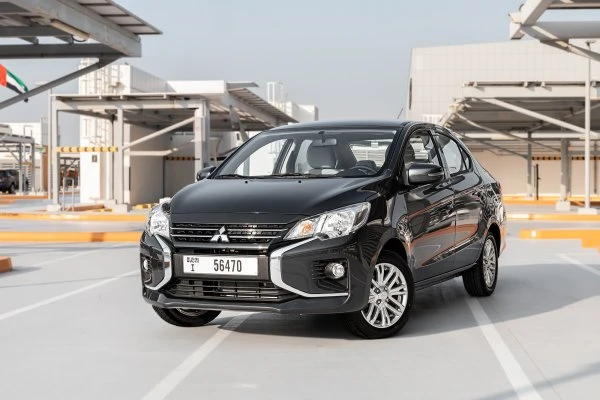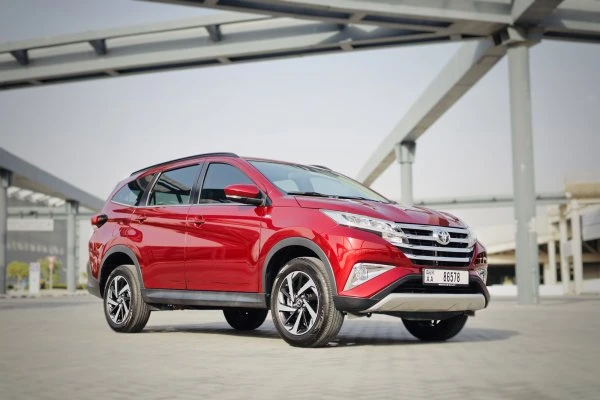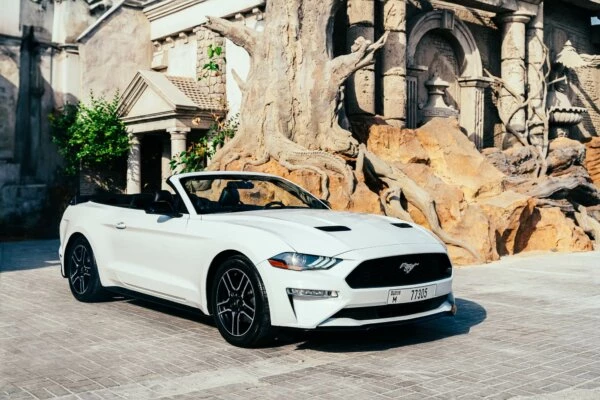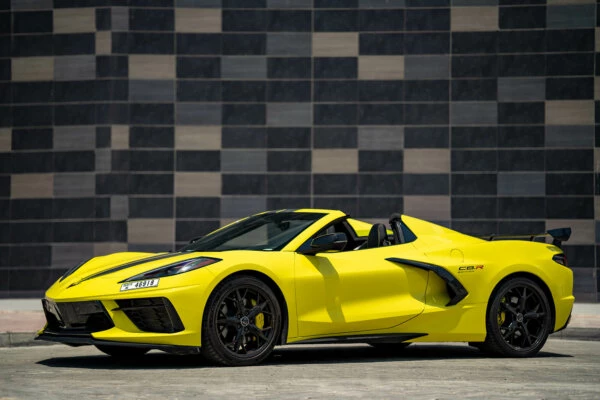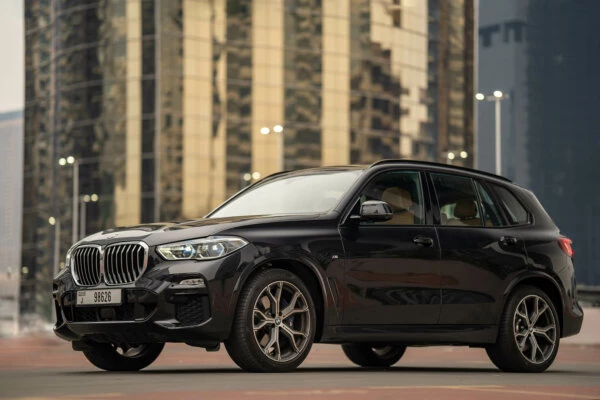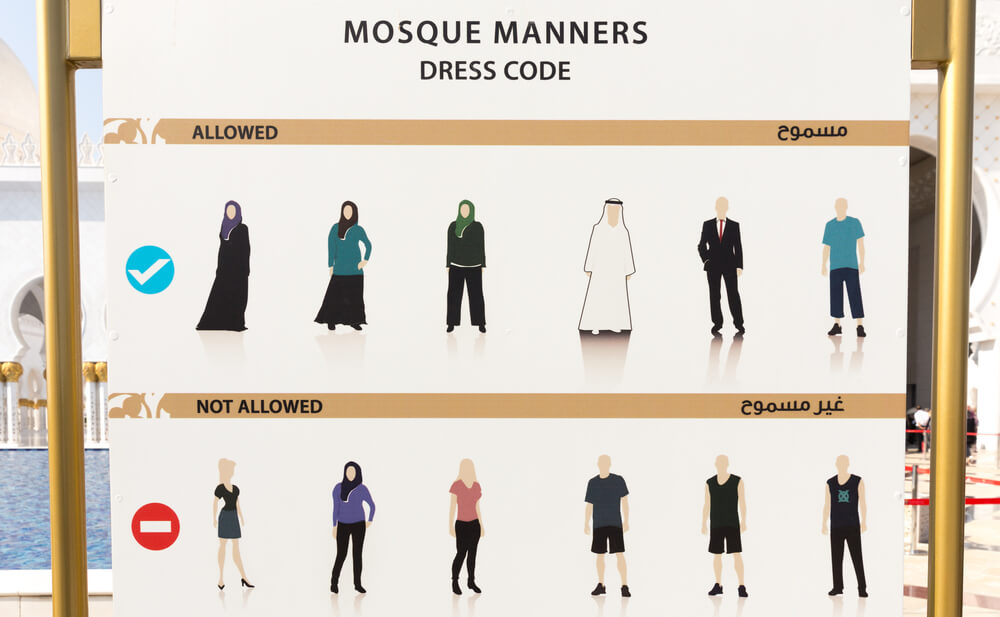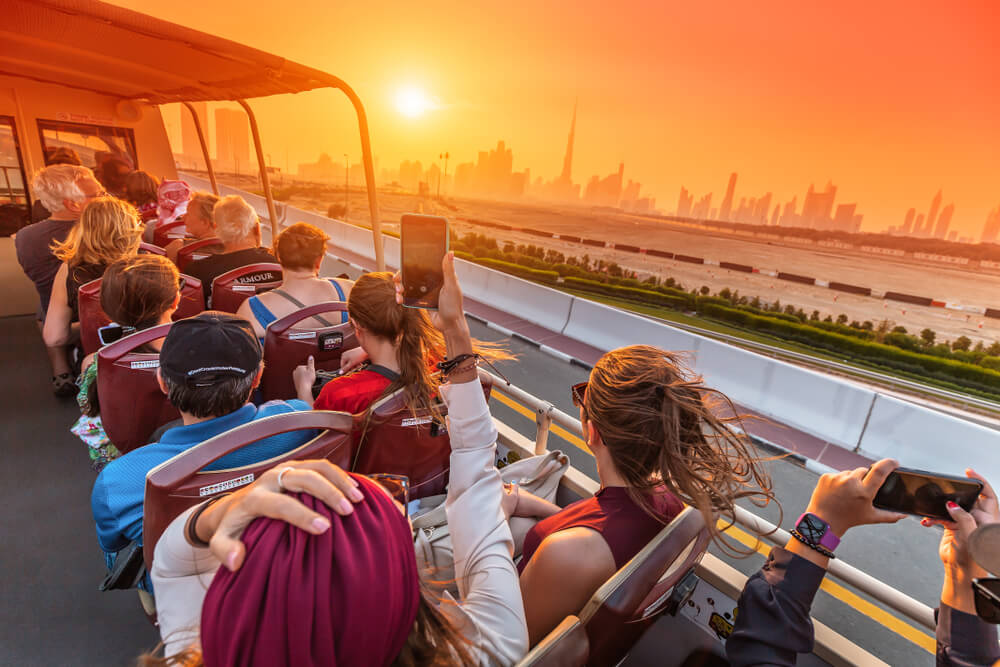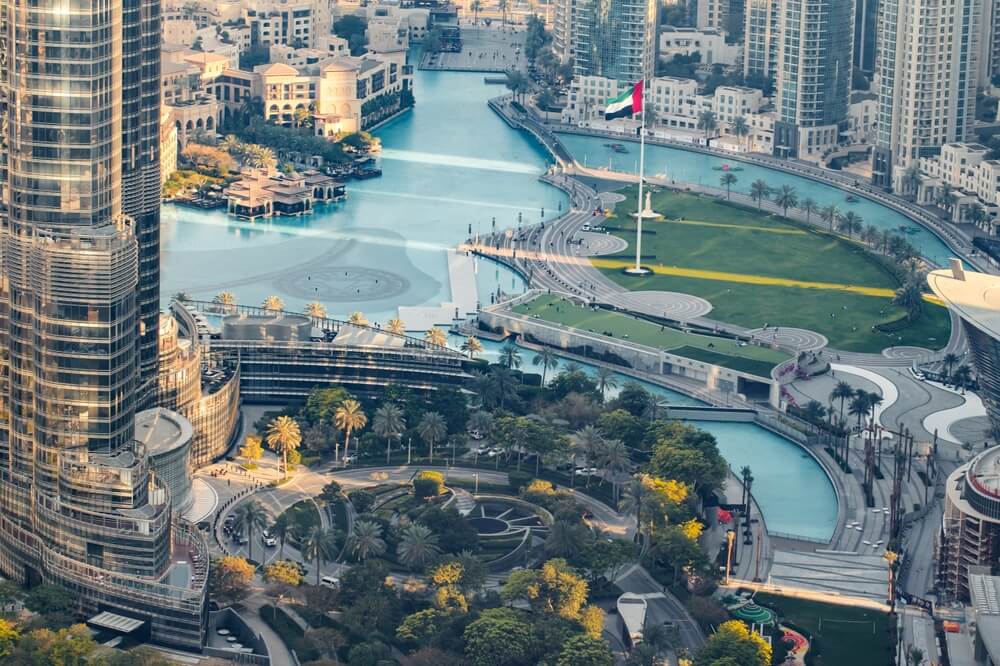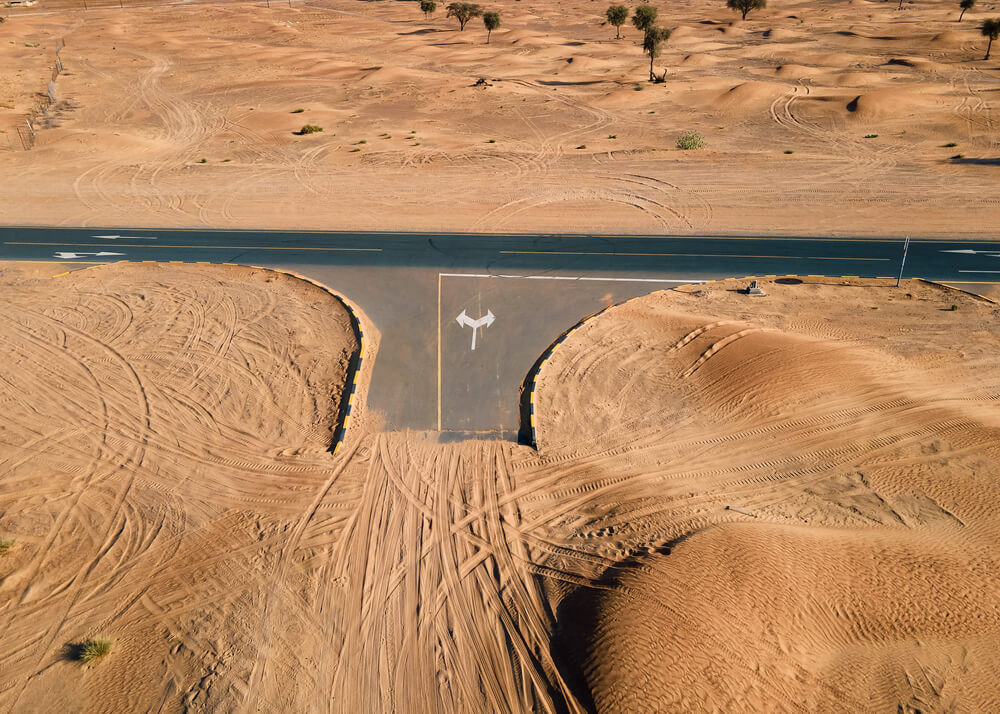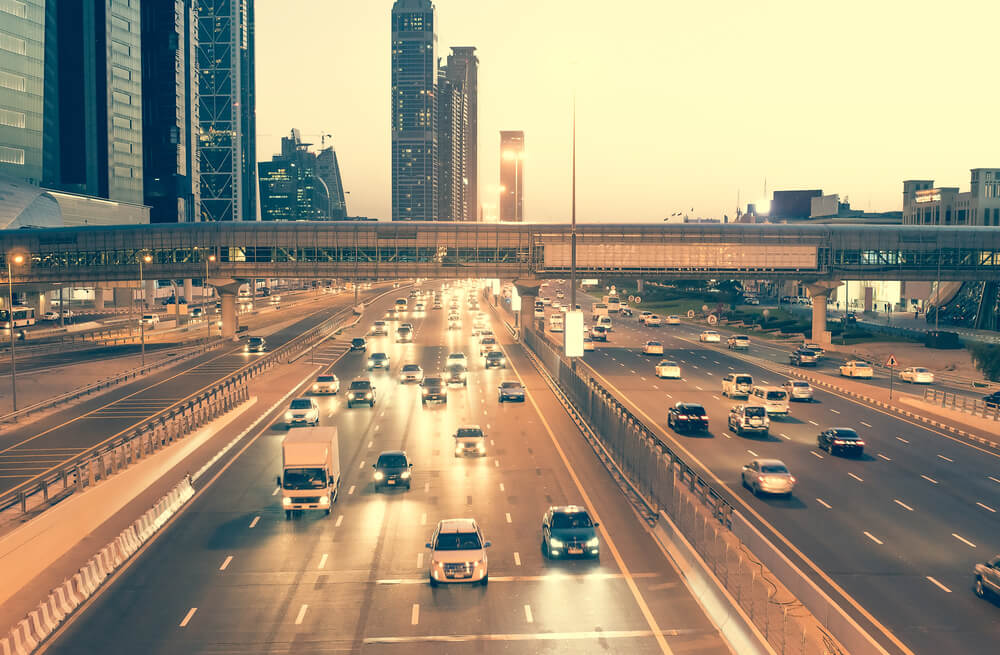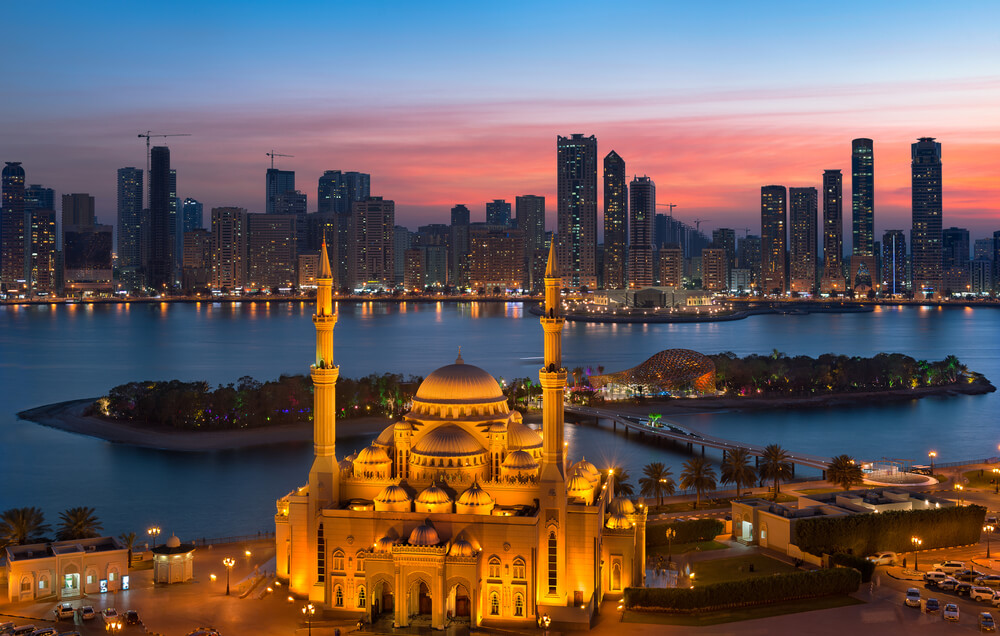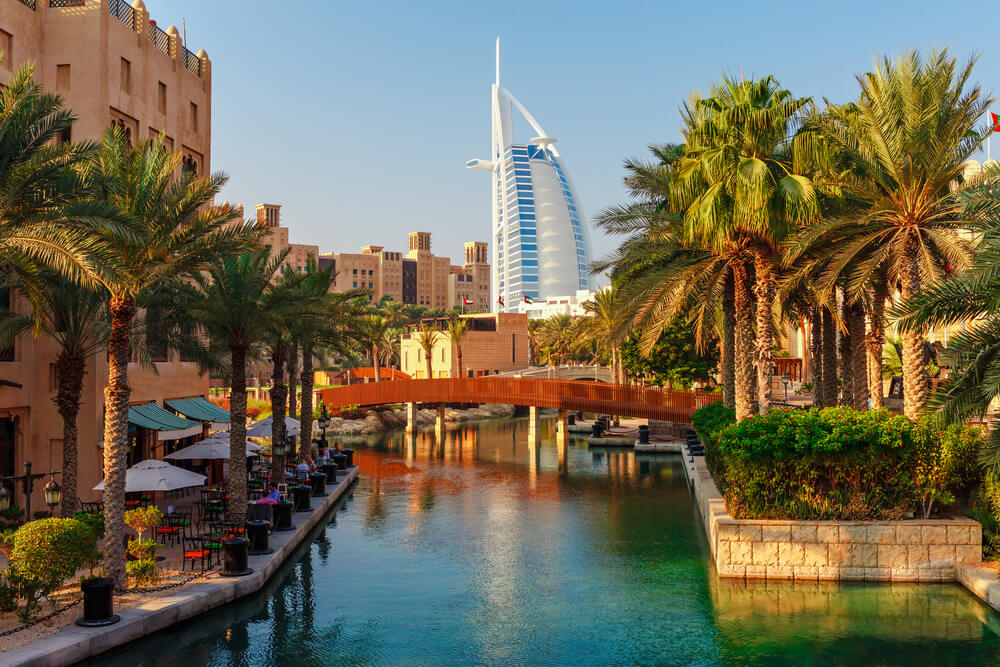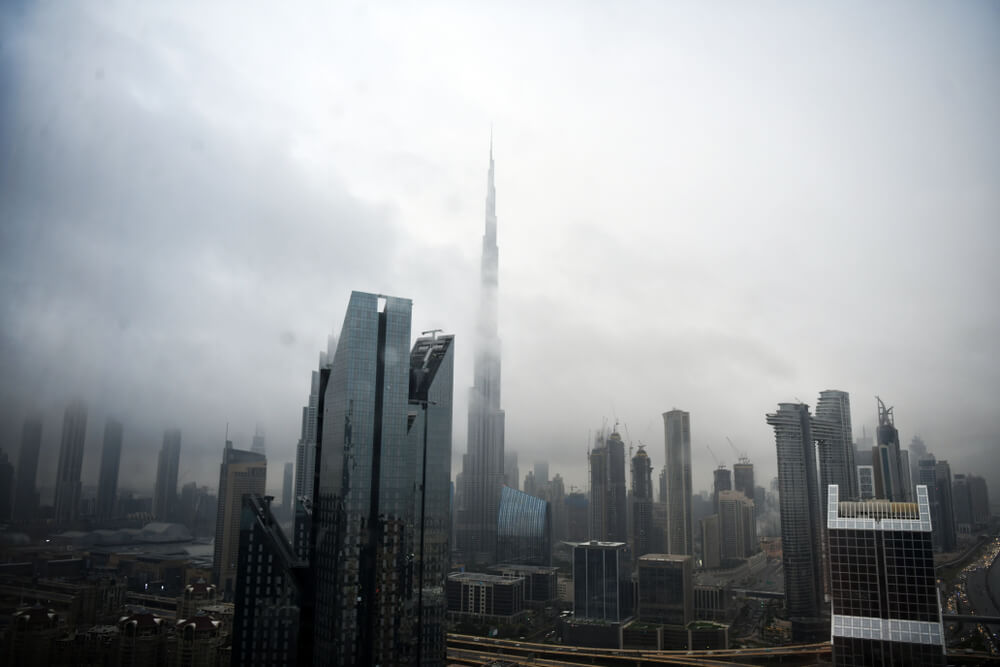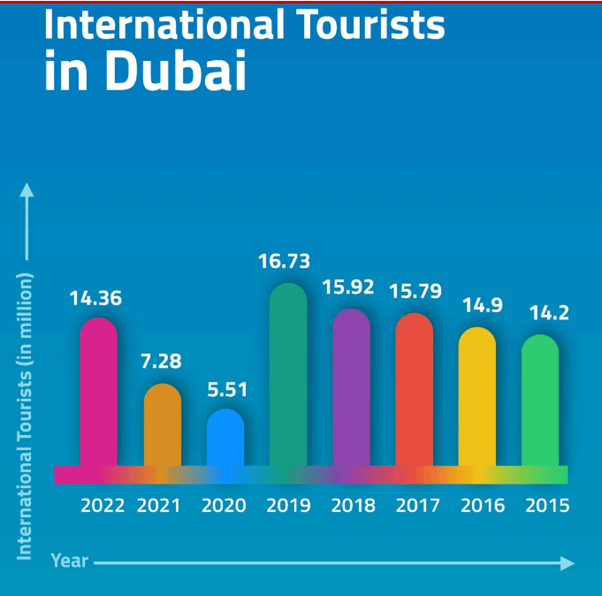Dubai is called a city of the future, but its history started in the early 18th century, when it was a modest and ordinary fishing village. Historical records suggest that by 1822, it had grown into a small town with around 700-800 members of the Bani Yas tribe. This tribe lived under the Sheikh Tahnun bin Shakhbut of Abu Dhabi.
Nowadays, it’s impossible to imagine that the emirate of Dubai was an oval-shaped small town surrounded by a mud wall. Today’s article will review the most fun and impressive Dubai facts.
Image is Everything
When you take a trip to Dubai, one thing becomes clear: this city is built for someone with an eye for beauty. Each skyscraper and each artificial island can become perfect Instagram, YouTube, or TikTok content. In Dubai, appearance matters, and here are eight facts that prove it:
- The World’s Tallest Fountain Jet: The Dubai Fountain shoots up to 152.4 meters of water, as tall as a 50-story building.
- The Skyscraper Capital of the Middle East: Dubai is home to more than 200 skyscrapers, including the iconic Burj Khalifa, the tallest building in the world at 828 meters. Many towers feature unique designs, like twists, curves, and cantilevers.
- The Sail-Shaped Building: The Burj Al Arab hotel was built to look like a ship’s sail. It’s one of the most photographed hotels in the world.
- Artificial Islands: Dubai is famous for artificial islands like Palm Jumeirah, which are shaped exactly like palm trees. Other projects include islands like the world map and heart-shaped islands for private luxury getaways.
- Photogenic decor: Dubai is built for photos, from golden camels at shopping malls to mirrored infinity bridges. Many public spaces, cafes, and even metro stations are designed aesthetically, so you’ll never lack Instagram content.
- Mega-Malls That Look Like Palaces: The Dubai Mall and Mall of the Emirates are visual gems, with choreographed fountains, indoor ski slopes, giant aquariums, and luxury architecture at every corner.
- Attention to Details: Even public benches, street lamps, and signage in Dubai follow specific design aesthetics. Many hotels have lobby chandeliers worth millions, and even airport terminals look like luxury lounges.
Fun Fact Regarding Dubai Police Force
Dubai has a well-equipped police force that uses luxury and sports cars as patrol vehicles, including models like the Bugatti Veyron and Ferrari FF. The city boasts an exceptionally low crime rate (close to zero).
As mentioned earlier, Dubai takes every opportunity to maintain a polished, picture-perfect image: from futuristic skyscrapers and man-made islands to beautiful public decor, and, of course, its luxury vehicles. In fact, the Dubai Police car fleet has become a tourist attraction, often photographed and admired like the city’s iconic landmarks.
Over 300 World Records
Dubai is called the city of superlatives for a reason. It holds over 300 world records and counting. Many of these record-breaking achievements are part of everyday life for residents and visitors alike. Of course, listing all 300 records would take a while. Let’s take a look at these five:
Dubai Frame: The Largest Frame in the World
The iconic Dubai Frame is the largest frame on the planet. At 150 meters tall and 93 meters wide, it offers panoramic views of both “old” and “new” Dubai, making it a top tourist attraction.
Busiest Airport by International Passenger Traffic
Dubai International Airport (DXB) consistently ranks as the busiest airport worldwide for international travelers. It’s also one of the largest airports in the Middle East regarding volume and capacity.
Gevora Hotel: Tallest Hotel in the World
While not the tallest building, the Gevora Hotel is the tallest hotel-only structure on Earth, standing at 356 meters. It reflects the luxury lifestyle that many Dubai residents and visitors expect.
XLine Dubai Marina: Longest Urban Zipline
Dubai Marina is home to the longest urban zipline in the world. It soars over skyscrapers and water canals, and is one of the city’s most adrenaline-pumping tourist attractions.
Deep Dive Dubai: Deepest Swimming Pool
At 60 meters deep, Deep Dive Dubai holds the world record for the deepest swimming pool. It also includes an underwater “sunken city” for divers to explore.
Strict Regulations
Although Dubai is known for being the most relaxed city in the United Arab Emirates, that doesn’t mean guests have permission to do anything they want. In Dubai, be ready to follow strict rules to avoid problems with the authorities. As you know, they have luxury cars to chase you down if needed.
- No kisses and hugs: You must respect the rules of the UAE, no matter if you are a tourist or a resident. Public displays of affection may result in fines and are considered inappropriate behavior.
- Don’t drink alcohol in public: You can drink alcohol in licensed places like bars. Drinking in public places such as parks, beaches, or streets is prohibited. Being drunk in public can end with fines and even arrest. Also, be careful with smoking and vaping.
- Respect Ramadan: During the holy month of Ramadan, eating, drinking, or smoking in public during daylight hours is forbidden. You must follow this rule even if you are non-Muslim out of respect for those fasting.
- Dress appropriately: Wear swimsuits only at the beach, avoid too revealing clothes (short skirts, crop tops, low-cut shirts) in public places.
- Avoid aggressive behavior: Dubai has strict laws against offensive behavior. Shouting, cursing, and making rude gestures can result in fines and even jail time.
Expats and Foreigners
- 10% of residents are Emirati citizens: Nearly 90% of the population of Dubai is expats. Residents of Dubai come from over 200 nationalities, making the city one of the most diverse places in the world.
- No personal income tax: One reason many professionals move to Dubai is the absence of an income tax on salaries. This has helped the city attract talent from around the globe.
- A global city for work: Dubai is home to a large international workforce. Expats play a key role in nearly every industry. The town offers a unique environment where people from vastly different backgrounds work and live side by side.
- Multicultural city: Known as the Dubai melting pot, it is a global hub for expats due to its open business climate and modern lifestyle. Hearing five or more languages on a single street is common, reflecting its truly international spirit.
The Tallest Building in The World: Burj Khalifa
The world’s tallest building, Burj Khalifa, is located in Dubai. At 828 meters, it is just a short drive from Jumeirah Beach. It is one of the most popular tourist attractions in the UAE, offering panoramic views of the entire city from its observation decks. However, the height of this building is something you can find on Google. Check these five crazy facts about Burj Khalifa:
- It can be seen from 95 km away.
- It needs 946,000 liters of water daily, and the building uses nearly 1 million liters daily for cooling, fountains, pools, and the sanitary system. That’s enough to fill almost 4,000 bathtubs every day.
-
Superheroes clean it. The building’s window-cleaning crew uses 136 specialized gondolas, which take 3 to 4 months to clean all the glass panels. By the time they finish, it’s time to start over. Some companies even let workers dress up as Spider-Man to entertain tourists.
- It hosts the world’s highest New Year fireworks display, the Burj Khalifa’s New Year’s Eve show, which includes lasers, fireworks, and massive LED displays. The explosions start from the very top of the spire, making it the highest-altitude fireworks display in the world.
- It has its smell. Burj Khalifa has its signature scent. A custom fragrance is pumped through its ventilation system, designed to reflect the building’s elegance.
A Unique Combination of Environments
Dubai has something for everybody. It’s a perfect spot for enjoying your time with family or a romantic trip for couples. Shopping enthusiasts can explore boutiques and brand stores, beach fans can relax on the shore and enjoy the Persian Gulf’s blue waters, and adventure seekers can head to the camel rides or go camping in the desert. If you’re a sports enthusiast, you can even go skiing in the desert in real snow.
Besides, Dubai hosts major festivals and events. No matter if you’re a comedy fan, art enthusiast, book lover, gourmet, or adore pets and exotic animals. Dubai will satisfy all your needs and preferences.
And this is not even half of the gems and wonders Dubai offers. It is full of architectural masterpieces and landmarks, and during the day and at night, it offers events, parties, and activities.
A Driving Haven
Dubai boasts one of the world’s best driving infrastructures. The roads are well-maintained, smooth, and far destinations are connected by highways. You won’t feel a lack of gas or charging stations, roadside cafes, and other comfortable driving amenities.
In Dubai, there is an innovative public transportation system. But you will need a car if you plan to travel a lot, drive around, and visit many significant places. Don’t have one? That is no problem because there are many car rental companies in Dubai. The selection of brands and models is nearly unmatched, offering almost every type of vehicle you might want, from affordable sedans to luxury SUVs and high-end sports cars.
Dubai is a haven for car culture fans. You can even find a museum with rare vintage cars. Driving a car here is not only about being transported from point A to point B. It’s about your status and prestige; the vehicle is also a perfect way to highlight your sophisticated taste.
Rules and regulations can be a bit confusing, but as long as you drive safely and respectfully, you’ll be fine. We suggest familiarizing yourself with parking zones and areas beforehand, since that’s probably the most challenging part of navigating Dubai by car.
Emirate Proximity
Dubai is a place where everyone can be happy and satisfied. Read our article highlighting the top places to visit in Dubai city and have your best time here. But don’t miss your chance to see other emirates, such as Sharjah and Abu Dhabi, and thanks to the excellent driving infrastructure, you can reach both of them within one and a half hours. There are no licenses or special permissions required to visit neighboring emirates. Many travelers visit nearby countries such as Oman, Saudi Arabia, and Qatar. However, entering these countries might require visas or other travel documents.
These emirates each have their own unique qualities and interesting attractions. For example, Sharjah is known as the most religious emirate, which is perfect for exploring the culture and history of the locals further. At the same time, Abu Dhabi is famous mainly for its entertainment parks, fantastic beaches, and the man-made Yas Island, which offers various attractions and activities. We recommend renting a car in Abu Dhabi to get around the city comfortably and quickly.
Desert Climate
Dubai is also famous for its hot summers, and tourists are recommended to visit the emirate anywhere between autumn and spring. It is the most-visited city during winter or its neighboring months, but many don’t know the severe weather conditions they should deal with if they live in Dubai during summer. For example, in 2023, the July temperature reached a whopping 50 °C, while the average for summer was 38 °C. The famous zoo closes its doors to save the animals and the visitors, desert safaris go on a summer break, many seaside activities become dangerous, and some industries go on hold.
Of course, some cultural, historical, and recreational attractions and activities are still available in summer. Some travelers prefer visiting Dubai at this time of the year because it’s the quiet time with the fewest crowds. However, unless you come from a similarly warm climate, it is recommended not to visit the emirate between June and August, as it might become dangerous for unprepared people.
Dubai leads the way in innovative cooling solutions, such as indoor temperature-controlled theme parks, misting systems in public spaces, and air-conditioned bus stops, which help make life more bearable when the temperature rises.
Almost No Rains
Following up on the weather topic, a mention of Dubai often highlights how rare rain is here. On average, the city gets around 25 rainy days a year, mostly short and mild. With an average annual rainfall of just 130mm, it’s six times lower than in the US and five times lower than in Spain.
Dubai was built with these conditions in mind, so heavy rain poses a major challenge for city services. Because there’s no proper drainage system in Dubai, the streets get flooded quickly, and many buildings aren’t really water-resistant.
A perfect example was the three-day rainstorm during the 2021 New Year’s celebration, which residents considered a big disaster. The authorities even issued yellow and orange alerts to warn people about outside dangers.
The Fastest Growth
- Population Boom: Over the past 50 years, Dubai’s population grew from 0.18 million in 1975 to 3.95 million in 2025 (more than 20-fold growth) — thousands of new arrivals yearly, mainly expats. Excellent living conditions attract people.
- Territorial Growth: Dubai covers 4,114 km² today and is the second-largest emirate in the UAE. Between 2000 and 2010, the most significant urban growth took place, marked by projects such as man-made islands and entirely new districts that transformed the coastline.
- Post-COVID Comeback: International arrivals dropped from 16.7 million in 2019 to 5.5 million in 2020, but by 2022 recovered to 14.4 million and jumped to 18.7 million in 2024.
- DXB Passenger Surge: Dubai International Airport had 18.2 million passengers in 2020. Yet, by 2024, that figure jumped to a record 92.3 million.
- Long-term Economic Expansion: Oil now contributes under 5 % of Dubai’s GDP. In 2023, real GDP reached USD 117 billion with 3.3 % growth, driven primarily by tourism, finance, trade, and real estate.
- Tourism Revenue Record: Tourist spending jumped from AED 117.6 billion in 2022 to AED 192 billion in 2024 (nearly double the post-pandemic low).
- Rising Resident Numbers: Dubai’s population continues to grow, thanks to initiatives like the Golden Visa and remote-work permits.
About the Largest Flower Garden
The Dubai Miracle Garden covers more than 72,000 square meters. As the largest natural flower garden, it combines over 150 million flowers. Let’s review some facts about the Miracle Garden in Dubai:
- Record-Breaking Scale: It is the biggest natural flower garden in the world, with over 150 million flowers blooming each season.
- Eco-Friendly Design: The garden uses drip irrigation to conserve over 75% of its water needs.
- Floral Projects: Among its 50+ installations are a full-sized Emirates A380 plane covered in flowers and life-size floral castles inspired by fairy tales. Also, you can walk under a giant heart arch made entirely of real flowers.
- Neighboring Butterfly Garden: Nearby is the world’s largest indoor butterfly garden, home to over 15,000 butterflies of over 50 species.
- Seasonal Rebuild: They redesign the layout each season. Every season starts with new sculptures, color schemes, and photo spots.
- Nighttime Illumination: After sunset, LED lights illuminate the blooms. The atmosphere is totally different at night.
Facts About the Largest Shopping Mall
- Dubai is a luxurious city, an epicenter of shopping. Dubai Mall covers more than 1.1 million square meters (about 200 football fields)
- There are more than 1200 stores, from Gucci and Chanel to Zara and H&M.
- Inside the mall, you’ll find one of the world’s largest indoor aquariums, holding 10 million liters of water and thousands of marine animals. You can even walk through it in a glass tunnel.
- Outside the mall is the famous Dubai Fountain, where you can watch water dance up to 152 meters high, choreographed to music and lights.
- That’s more than the total number of visitors to New York City or Paris annually! Dubai Mall is one of the most visited tourist attractions in the world.
- Inside the mall, you’ll find a 155-million-year-old Diplodocus longus skeleton (over 7 meters tall and 24 meters long).
- The mall features a Waterfall Wall with silver divers and many luxurious lounges and cafes.
- During the Dubai Shopping Festival, Dubai Mall offers huge sales, daily prize draws, music and dance shows, holiday lights, and special temporary stores from big brands.
Random Facts about Dubai
- Busiest airport: Dubai International Airport consistently ranks among the world’s busiest by international passenger traffic. Ironically, many city areas still rely on landmarks and phone calls rather than traditional street addresses.
- Largest artificial island: The largest artificial island group is The World Islands. It’s a collection of man-made islands shaped like a world map, visible even from space.
- Camel racing with jockey robots: Camel races are a cultural tradition, but modern Dubai has replaced child jockeys with robot riders operated by remote control for safety and efficiency.
- Weekends start on Friday: As of January 2022, the UAE’s weekend officially moved to Friday (half-day) and Saturday, matching most businesses’ weekend, Saturday, and Sunday (though Sunday remains a working day for many).
- ATMs that dispense gold: Dubai is a city of gold, and these ATMs are proof of that.
- Water from desalination: Dubai relies heavily on technology to turn seawater into freshwater. Rainfall is minimal, and every drop is managed carefully.
- Ramadan and daily life: During the holy month, restaurants close during daylight hours, working hours are reduced, and the city’s rhythm changes.
- Desert skiing: At Ski Dubai, a massive indoor snow park inside the Mall of the Emirates, you can ski, snowboard, and meet penguins. While outside is a desert climate, you can cool down and enjoy some winter adventure.
Short Interesting Facts About Dubai
- Dubai World Cup: Known as the world’s richest horse race, the Dubai World Cup offers a prize pool of around $12 million. The horse Thunder Snow won the race twice successively in 2018 and 2019.
- Dubai Initiatives: Dubai takes innovation seriously. For example, Dubai Pulse is a project for real-time city data analysis. It helps to improve traffic and safety. In 2022, Dubai Municipality improved waste recycling rates to 70% and planted over 1 million trees.
- Dubai Celebration Chain: Dubai’s year-round celebration chain (which includes festivals like the Dubai Shopping Festival and Al Marmoom Heritage Festival) attracts millions of tourists. During the 2022 Dubai Shopping Festival alone, more than 3 million transactions totaled over $3 billion.
- Dubai’s Economy: Although oil initially boosted the city’s growth, it now makes up less than 1% of its GDP. Nowadays, tourism, finance, trade, and real estate are the main sectors driving the economy.
- Dubai Government: The government handles laws, police, and the economy. While the UAE has a federal government and an emirate council, Dubai can make decisions independently. .
